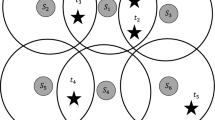Abstract
A critical aspect of applications with wireless sensor networks is network lifetime. Battery-powered sensors are usable as long as they can communicate captured data to a processing node. Sensing and communications consume energy, therefore judicious power management and scheduling can effectively extend operational time. To monitor a set of targets with known locations when ground access in the monitored area is prohibited, one solution is to deploy the sensors remotely, from an aircraft. The loss of precise sensor placement would then be compensated by a large sensor population density in the drop zone, that would improve the probability of target coverage. The data collected from the sensors is sent to a central node for processing. In this paper we propose an efficient method to extend the sensor network operational time by organizing the sensors into a maximal number of disjoint set covers that are activated successively. Only the sensors from the current active set are responsible for monitoring all targets and for transmitting the collected data, while nodes from all other sets are in a low-energy sleep mode. In this paper we address the maximum disjoint set covers problem and we design a heuristic that computes the sets. Theoretical analysis and performance evaluation results are presented to verify our approach.
Similar content being viewed by others
References
ANSI/IEEE, Standard 802.11, Wireless LAN Medium Access Control (MAC) and Physical Layer(PHY) specifications (1999).
L. Benini, G. Castelli, A. Macii, E. Macii, et al., A discrete-time battery model for high-level power estimation, in: Design, Automation and Test in Europe Conference (2000) pp. 35–39.
M. Cardei, D. MacCallum, X. Cheng, M. Min, X. Jia, D. Li and D.-Z. Du, Wireless sensor networks with energy efficient organization, Journal of Interconnection Networks 3(3/4) (2002) 213–229.
I. Chlamtac, C. Petrioli, and J. Redi, Energy-conserving access protocols for identification networks, IEEE/ACM Transactions on Networking 7(1) (1999) 51–59.
ETSI EN 300 652, V 1.2.1, Broadband Radio Access Networks (BRAN); High Performance Radio Local Area Network (HIPERLAN) Type 1; Functional Specification (July 1998).
M. R. Garey and D. S. Johnson, Computers and Intractability. A Guide to the Theory of NP-Completeness (Freeman, New York, 1979).
P. Karn, MACA–-A New Channel Access Method for Packet Radio, in: ARRL/CRRL Amateur Radio 9th Computer Networking Conference (1990) pp. 134–140.
C.S. Raghavendra and S. Singh, PAMAS-Power Aware Multi-Access protocol with Signaling for Ad Hoc Networks, Computer Communications Review (July 1998).
S. Slijepcevic and M. Potkonjak, Power Efficient Organization of Wireless sensor Networks, in: IEEE International Conference on Communications, Helsinki, Finland (June 2001).
J. Stine and G. de Veciana, Improving energy efficiency of centrally controlled wireless data networks, Wireless Networks 8(6) (2002) 681–700.
Author information
Authors and Affiliations
Corresponding author
Additional information
Mihaela Cardei is an Assistant Professor in the Department of Computer Science and Engineering at the Florida Atlantic University. Her research interests are in the areas of wireless networking, wireless sensor networks, algorithm and protocol design in communication networks and resource management. Mihaela Cardei received her M.S. and Ph.D. in Computer Science from the University of Minnesota in 1999 and 2003 respectively. Her Ph.D. adviser was Dr. Ding-Zhu Du. During her graduate studies, she worked with Honeywell Laboratories on the Real Time Adaptive Resource Management DARPA project. She is also a recipient of the University of Minnesota Graduate School Doctoral Dissertation Fellowship for 2002–2003.
Ding-Zhu Du received his M.S. degree in 1982 from Institute of Applied Mathematics, Chinese Academy of Sciences under the supervision of Minyi Yue, and his Ph.D. degree in 1985 from the University of California at Santa Barbara under the supervision of Ronald V. Book. He worked at Mathematical Sciences Research Institute, Berkeley in 1985–86, at MIT in 1986–87, and at Princeton University in 1990–91. Currently, he is a professor at Department of Computer Science, University of Minnesota and also a research professor at Institute of Applied Mathematics, Chinese Academy of Sciences. His research interests include combinatorial optimization, communication networks, and theory of computation. He has published more than 140 journal papers and 30 books. Currently, he is the editor-in-chief of Journal of Combinatorial Optimization and book series on Network Theory and Applications. He is also in editorial boards of eight journals.
Rights and permissions
About this article
Cite this article
Cardei, M., Du, DZ. Improving Wireless Sensor Network Lifetime through Power Aware Organization. Wireless Netw 11, 333–340 (2005). https://doi.org/10.1007/s11276-005-6615-6
Issue Date:
DOI: https://doi.org/10.1007/s11276-005-6615-6




